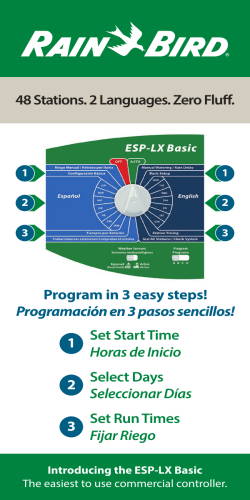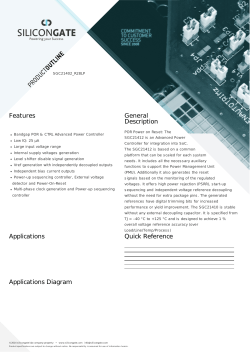
RUBY ON RAILS CS 186 – Arsalan Tavakoli 3/18/2008
Slides adapted from CS 198 slides with the
gracious permission of Armando Fox and Will
Sobel
RUBY ON RAILS
CS 186 – Arsalan Tavakoli
3/18/2008
Today’s Agenda / Goals
Evolution of the Web
What is Ruby on Rails?
Brief overview of Ruby
Rails
CRUD
Active Records/Controller/Views
Rendering
(Too Much to List Here)
Probably won’t finish it all, but serves as a good
reference
Web 1.0
Web 1.0: user interaction == server roundtrip
Other than filling out form fields
Every user interaction causes server roundtrip
Every roundtrip causes full page redraw
Web 1.5: user interactions without contacting server
e.g. form validation before submit
e.g. selecting something from menu A causes contents of
menu B to change
But every roundtrip still causes full page redraw
Web 2.0
Separation of server roundtrip from page rendering
Initial load of page & draw page
User interaction causes background roundtrip to server
Response from server “captured” and passed to a programmerdefined JavaScript function
That function can redraw part of the page in place (using same
mechanisms as Web 1.5)
Result: “desktop-like” responsive UI’s that can contact
server
Auto completion
“Lazy” fetch of complicated parts of page
etc
What is Ruby on Rails?
Ruby is a language that is...
Rails is a web application framework that...
dynamically typed, interpreted, object-oriented, functionallyinspired
embodies the MVC design pattern
emphasizes convention over configuration
leverages Ruby language features incl. dynamic typing,
metaprogramming, & object-orientation to provide elegant
support for both goals
Rails handles everything up to the point where your code
is called
And everything past the point where your code delivers
stuff to the user.
A Couple of Notes
We are using Rails 1.2.3, not Rails 2.0
Slight
differences between the two, be careful when
looking at tutorials on the web.
Install RoR on your computer for easier access
InstantRails
for Windows
Locomotive for Mac OSx
LOTS of simple ROR tutorials out there
Rolling
with Ruby on Rails (Revisited) is the most popular
and a good place to start
Ruby
Purely Object-Oriented Language
EVERYTHING
Borrows from:
Lisp,
is an object, and EVERYTHING has a type
Perl, Smalltalk, and CLU
Exists outside of Rails (but the reverse isn’t true)
irb: Ruby’s built-in interpreter to test out commands
and test code
ri: Ruby’s equivalent to ‘man’
Variables
A Variable in Ruby holds objects
Since
everything is an object, a variable can hold
anything!
Variable names indicate scope, not type
Local
Variable: foo, bar, _temp
Instance Variable: @foo, @bar, @_temp
Symbol: :foo, :bar, :_temp
Array: [1, “1”, :one]
Hash: { :one => 1, ‘two’ => 2}
Review: Naming Conventions & Syntax
ClassNames
class NewRubyProgrammer ...
method_names and variable_names
def learn_conventions
...
end
predicate_like_methods?
def is_faculty_member?
end
...
end
Return values
Each method returns a single object
If no explicit return statement, then return object is that which was
last referenced.
Def return_10(v)
10;
End;
Review: Syntax
Syntax features
Whitespace is not significant (unlike Python)
Statements separated by semicolons or newlines
Statement can span a newline*
Parentheses can often be omitted*
*
when unambiguous to parser; use caution!!
raise "D'oh!" unless valid(arg)
raise "D'oh!" unless
valid arg
raise "D'oh!"
unless valid(arg)
Advice: use a good text editor
The MVC Design Pattern
Goal: separate organization of data (model) from UI & presentation (view) by
introducing controller
mediates user actions requesting access to data
presents data for rendering by the view
Web apps are “sort of” MVC by design
• User actions
• Directives for
rendering data
Controller
.rb (Ruby)
code
.rhtml template
View
(or .rjs, .rxml...)
• Data provided to
views
• Read data
• Update data
SQL table +
Model
Ruby class
A Less Trivial Example...
Let’s walk through a full (single-table) MVC example...
1.
Design the model
2.
Instantiate the model (table & Ruby code)
3.
Basic controller to do CRUD (Create, Read,
Update, Destroy) operations on model
SQL 001
A SQL table has a number of rows of identical
structure
Each row has several columns (fields, attributes, etc.)
You can define relationships between tables
(associations)—we’ll get to that later
A collection of tables & relationships is called a
schema
MVC in RoR: Convention over
Configuration
If data model is called Student:
model (Ruby class) is app/models/student.rb
SQL table is students
table row = object instance
columns = object methods (a/k/a object instance variables)
controller methods live in app/controllers/student_controller.rb
views are app/views/student/*.erb.html
and other types of views we'll meet later
Preview: CRUD in SQL
4 basic operations on a table row: Create, Read,
Update attributes, Destroy
INSERT INTO students
(last_name, ucb_sid, degree_expected)
VALUES (“Fox”, 99999, “1998-1215”),
(“Bodik”, 88888, “2009-06-05”)
SELECT * FROM students
WHERE (degree_expected < “2000-01-01”)
UPDATE students
SET degree_expected=“2008-06-05”
WHERE last_name=“Bodik”)
DELETE FROM students WHERE ucb_sid=99999
Rails ActiveRecord models
ActiveRecord, a major component of Rails...
Uses SQL tables as underlying storage, and SQL commands as
underlying manipulation, of collections of Ruby objects
(Later) Provides an object-relationship graph abstraction using SQL
Joins as the underlying machinery
Oversimplification: 1 instance of Ruby class Foo == 1 row in
a SQL table called Foos
Let Rails do the work of creating our model and related
stuff:
script/generate scaffold student
last_name:string first_name:string
ucb_id:integer degree_expected:datetime
More to notice about scaffolding
identical app/models/student.rb
create test/unit/student_test.rb
create test/fixtures/students.yml
For
creating
create app/views/students/_form.rhtml
test cases
create app/views/students/list.rhtml
CRUD
on student
views
create app/views/students/show.rhtml
model &
create app/views/students/new.rhtml
controller
create app/views/students/edit.rhtml
create app/controllers/students_controller.rb
create test/functional/students_controller_test.rb
create app/helpers/students_helper.rb
Capture common
create app/views/layouts/students.rhtml
elements of
create public/stylesheets/scaffold.css
student-related
views
Creating the Students table
We’re not done yet! Students table doesn’t exist...so
let’s define a student
edit the migration file 001_create_students.rb
give each student a first & last name, UCB ID, degree date
Let Rails do the work of interacting with the
database:
rake db:migrate
Question: what database?
config/database.yml
While we’re on SQL...
what’s a primary key anyway?
Column whose value must be unique for every table row
Why not just use (e.g.) last name or SID#?
SQL AUTO_INCREMENT function makes it easy to specify an integer primary
key
If using migrations to create tables (recommended), Rails takes care of
creating an autoincrement primary key field called ID
class CreateStudents<ActiveRecord::Migration
CREATE TABLE students (
id INT NOT NULL AUTO_INCREMENT,
last_name VARCHAR(255),
first_name VARCHAR(255),
ucb_sid INT(11) DEFAULT 9999
);
def self.up
create_table :students do |tbl|
tbl.column :last_name, :string
tbl.column :first_name, :string
tbl.column :ucb_sid, :integer,
:null=>false, :default=>9999
end
end
def self.down
drop_table :students
end
end
Recap
CRUD, the four basic operations on database rows
ActiveRecord, a library that arranges to “map” your
models into database rows
scaffolding gets your app off the ground early, then
you can selectively replace it
captures common model of a Web front-end to CRUD
operations
convention over configuration makes both of the
above tractable to implement while saving you work
Active Record: what is it?
A class library that provides an object-relational
model over a plain old RDBMS
Deal with objects & attributes rather than rows &
columns
result rows enumerable collection
(later) object graph join query
SELECT
More on Student Example
object attributes are “just” instance methods (a la
attr_accessor)
so
can already say stu.last_name, stu.ucb_sid,
etc.
what line in what file makes this happen?
ActiveRecord accessors/mutators
default
attr_accessor for each table column
perform
type-casting as needed
can be overridden, virtualized, etc.
Example: a short tour
Predicate-like method
names often end with
question mark
self (like Java this) not
strictly necessary here
Some useful class
methods of Date
Interpolation of
expressions into strings
Constructors
Method named initialize, but invoked as new
(at least) 3 ways to call it...
New != Create
Call s.save to write the object to the database
s.create(args) s.new(args); s.save
s.update_attributes(hash) can be used to update attributes in
place
s.new_record? is true iff no underlying database row corresponds to s
save does right thing in SQL (INSERT or UPDATE)
Convention over configuration:
if id column present, assumes primary key
if updated_at/created_at columns in table, automatically are set to
update/creation timestamp
find() SQL SELECT
# To find an arbitrary single record:
s = Student.find(:first) # returns a Student instance
# To find all records:
students = Student.find(:all) # returns enumerable!
# find by 'id' primary key (Note! throws RecordNotFound)
book = Book.find(1235)
# Find a whole bunch of things
ids_array = get_list_of_ids_from_somewhere()
students = Student.find(ids_array)
# To find by column values:
armando = Student.find_by_last_name('Fox') # may return nil
a_local_grad =
Student.find_by_city_and_degree_expected('Berkeley',
Date.parse('June 15,2007')
# To find only a few, and sort by an attribute
many_localgrads =
Student.find_all_by_city_and_degree_expected('Berkeley',
Date.parse('June 15,2007'),:limit=>30,:order=>:last_name)
Find by conditions
• Use ? for values from parameters. Rails will sanitize the
SQL and prevent any SQL injection
You can also specify ordering and use arbitrary SQL operators:
# Using SQL conditions
books = Book.find(:all,
:conditions => [‘pub_date between ? and ?’,
params[:start_date], params[:end_date]],
:order => ‘pub_date DESC’)
Find by conditions
Use ? to substitute in condition values
not mandatory, but a good idea!
You can include other SQL functionality
# Using SQL conditions
books = Book.find(:all,
:conditions => [‘pub_date between ? and ?’,
params[:start_date], params[:end_date]],
:order => ‘pub_date DESC’)
You can roll your own
s = Student.find_by_sql("SELECT * FROM students ...")
Advanced Find
You can also specify limits and offsets, and oh so much more
books = Book.find(:all,
:conditions => [‘pub_date between ? and ?’,
params[:start_date], params[:end_date]],
:limit => 10, :offset => params[:page].to_i * 10)
• :lock - Holds lock on the records (default: share lock)
• :select - Specifies columns for SELECT (default *)
• :group - (used with select) to group
• :readonly - load as read-only (object can’t be saved)
• :include - Prefetches joined tables
• Note: use SQL-specific features at your own risk....
Caveat!
The result of a find-all operation mixes in
Enumerable
Enumerable defines methods find and
find_all
Not to be confused with
ActiveRecord::Base#find!
Action View
A template for rendering views of the model that allows some
code embedding
“Helper methods” for interacting with models
commonly RHTML (.html.erb); also RXML, HAML, RJS
note...too much code breaks MVC separation
convention: views for model foo are in app/views/foo/
model valuesHTML elements (e.g. menus)
HTML form inputassignment to model objects
DRY (Don’t Repeat Yourself) support
Layouts capture common page content at application level, model level,
etc. (app/views/layouts/)
Partials capture reusable/parameterizable view patterns
Helper Methods for Input & Output
Views: Insert Ruby code snippets among HTML
Anatomy: <% code %> <%= output %>
But these form tags are generic...what about model-specific
form tags?
In the RHTML template:
<%= form_for(@student) do |f| %>
...etc....
In HTML delivered to browser:
<input id="student_last_name"
name="student[last_name]" size="30" type="text"
value="Fox" />
What happened?
Action Controller
Each incoming request instantiates a new Controller
object with its own instance variables
Routing determines which method to call
Parameter unmarshaling (from URL or form sub.) into
params[] hash
...well, not really a hash...but responds to [], []=
Controller methods set up instance variables
these will be visible to the view
controller has access to model’s class methods; idiomatically,
often begins with Model.find(...)
Then we render...
Once logic is done, render the view
exactly one render permitted from controller method (1
HTTP request 1 response)
Convention over configuration: implicit render
if no other render specified explicitly in action method
looks for template matching controller method name and
renders with default layouts (model, app)
What about those model-specific form
elements?
Recall:
<input type="text" id="student_last_name"
name="student[last_name]"/>
Related form elements for student attributes will be
named student[attr ]
marshalled into params as
params[:student][:last_name],
params[:student][:degree_expected], etc.
i.e, params[:student] is a hash :last_name=>string,
:degree_expected=>date, etc.
and can be assigned directly to model object instance
helpers for dates and other “complex” types...magic
What else can happen?
redirect_to allows falling through to different
action without first rendering
fallthrough action will call render instead
works using HTTP 302 Found mechanism, i.e. separate
browser roundtrip
example: update method
fail: render the edit action again
success: redirect to “URL indicated by this @student object”
alternate (older) syntax for redirects:
redirect_to :action => 'show', :id => @student.id
The Session Hash
Problem: HTTP is stateless (every request totally
independent). How to synthesize a session (sequence
of related actions) by one user?
Rails answer: session[] is a magic persistent hash
available to controller
Actually, it’s not really a hash, but it quacks like one
Managed at dispatch level using cookies
You can keep full-blown objects there, or just id’s (primary
keys) of database records
Deploy-time flag lets sessions be stored in filesystem, DB
table, or distributed in-memory hash table
The Flash
Problem: I’m about to redirect_to
somewhere, but want to display a notice to
the user
yet that will be a different controller instance
with all new instance variables
Rails answer: flash[]
contents are passed to the next action, then
cleared
to this action: flash.now[:notice]
visible to views as well as controller
• Strictly speaking, could use session & clear it out yourself
Controller predicates: verify
A declarative way to assert various preconditions on calling
controller methods
You can check selectively (:only, :except) for:
And if the check fails, you can...
HTTP request type (GET, POST, Ajax XHR)
Presence of a key in the flash or the session
Presence of a key in params[]
redirect_to somewhere else
add_to_flash a helpful message
Example:
verify :method => :post, :only => 'dangerous_action',
:redirect_to => {:action => 'index'},
:add_to_flash => "Dangerous action requires Post"
More General Filters
Code blocks that can go before, after or around controller actions; return
Boolean
before_filter :filter_method_name
before_filter { |controller| ... }
before_filter ClassName
If any before-filter returns false, chain halted & controller action method won’t
be invoked
options include :only,:except, etc.
multiple filters allowed; calls provided to prepend or append to filter chain
subclasses inherit filters but can use skip_filter methods to selectively disable
them
so filter should redirect_to, render, or otherwise deal with the request
Simple useful example: a before-filter for nested routes!
before_filter :load_professor
def load_professor
@professor = Professor.find(params[:professor_id])
end
Intro. to Associations
Let’s define a new model to represent Courses.
keep it simple: name, CCN, start date (month & year)
What’s missing: a way to identify who is in the class!
Rails solution: (similar to database foreign keys)
Add column course_id to Students table
Declare that a Course has_many :students
Both of these are Rails conventions
Set a given student’s course_id field for the course
they are taking
An obvious problem with this approach...but we’ll fix it later
Associations In General
x has_many y
the
y table has an x_id column
y belongs_to x
Note! Table structure unaffected by whether you also
define the belongs_to....so why do it?
x has_one y
actually
like has_many: does same SQL query but
returns only the first result row
Using Associations
Going forward (course has_many students):
@c = Course.find(...)
@s = @c.students
What
is the “type” of @s?
Going the other way (student belongs_to course):
@s = Student.find(...)
@c = @s.course
Modeling professors
How should we change the schema to support course
belongs_to professor?
What about all the students that a
professor teaches?
@p = Professor.find(...)
@c = Professor.courses
@s = @c.students
Or....
Now we can just write:
@s = Professor.find(...).students
What is happening in terms of tables
in this example?
SQL is doing a join
Which you’ll learn about next time....
The message is:
Active Record tries to provide the abstraction of an
object graph by using SQL table joins.
The xxx_id fields are called foreign keys.
Virtual attributes example: simple
authentication
Assume we have a table customers with columns salt
and hashed_password...
Defines the receiver method
for password=
Why do we want to use self here?
Where’s the accessor for
password?
Summary
ActiveRecord provides (somewhat-)databaseindependent object model over RDBMS
ActionView supports display & input of model objects
facilitates reuse of templates via layouts & partials
ActionController dispatches user actions, manipulates
models, sets up variables for views
declarative specifications capture common patterns for
checking predicates before executing handlers
$APP_ROOT/config/routes.rb
Ruby code (that makes use of high-level methods!)
to declare “rules” for mapping incoming URLs to
controllers/actions
actually each rule has 2 purposes:
1.
2.
map incoming URL to ctrler/action/params
generate URL to match ctrler/action/params
–
–
e.g. when using link_to, redirect_to, etc.
What’s in a rule?
A URL template
Keywords stating what to do
Simple example
In routes.rb:
map.connect 'professors/:dept',
:controller => 'professors', :action => 'list'
In one of your views:
<%= link_to "List professors in EECS",
:controller => 'professors', :action => 'list',
:dept => 'eecs', :hired_since => 2005 %>
matching
is determined by keywords
link_to uses underlying function url_for, which
consults routing rules to build the URL:
http://www.yourapp.com/professors/eecs?hired_since=2
005
Simple example cont.
In routes.rb:
map.connect 'professors/:dept',
:controller => 'professors', :action => 'list'
Now if someone visits this URL:
http://www.yourapp.com/professors/eecs
Matching
is determined by position
How about:
http://www.yourapp.com/professors/eecs?glub=1&hired_
since=2006
How about:
http://www.yourapp.com/professors
Default routes
URL is compared to routing rules, one at a time, until
match found
then “wildcard” pieces of URL get put into params[]
If no match, default route (last one in routes.rb) is used
typically something like:
map.connect ':controller/:action/:id'
e.g., catches things like professors/edit/35
Warning! Can lead to dangerous behaviors
Use the root route to map the “empty” URL (e.g.
http://www.myapp.com):
map.root :controller=>'main', :action=>'index'
More on Routes
Ordering of routes matters; more specific ones
should come earlier so they’ll match first
map.connect 'users/:action/:id'
map.connect ':controller/:action/:id'
Many, many apps will never need to use more than
the “conventional” predefined routes
If you want to, you should definitely read more
about routes offline
REST is CRUD
REST Idea: each HTTP interaction should specify, on
its own, a CRUD operation and which object to do it
on.
GET
used for read operations; POST for writes (create,
update, delete)
Also guards against spidering/bots!
Rails 2.0: routes, scaffolds and URL helpers are now
all RESTful by default
result:
syntax of link_to, etc. has changed
Get them by saying map.resources :model
REST and URI’s
Action & named route
method to pass to url_for
HTTP
method
Old style URL
New (RESTful)
style URL
show: student_url(@s)
GET
/:ctrl/show/:id
/:ctrl/:id
/:ctrl/list (or
/:ctrl/index)
/:ctrl
index (list): students_url GET
new: new_student_url
GET
/:ctrl/new
/:ctrl/new
create: students_url
POST
/:ctrl/create
(why no ID?)
/:ctrl
destroy:
DELETE
/:ctrl/destroy/:id
/:ctrl (but see
Hack!)
GET
/:ctrl/edit/:id
/:ctrl/:id/edit
/:ctrl/update/:id
/:ctrl/:id
student_url(@s)
edit:
edit_student_url(@s)
update: student_url(@s) PUT
© Copyright 2025











